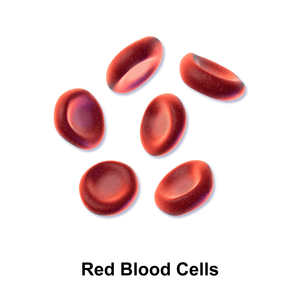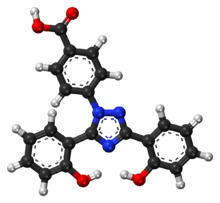Congenital dyserythropoietic anemia
| Congenital dyserythropoietic anemia | |
|---|---|
 | |
| CDA causes decrease in red blood cells | |
| Classification and external resources | |
| Specialty | hematology |
| ICD-10 | D64.4 |
| ICD-9-CM | 285.8 |
Congenital dyserythropoietic anemia (CDA) is a rare blood disorder, similar to the thalassemias. CDA is one of many types of anemia, characterized by ineffective erythropoiesis, and resulting from a decrease in the number of red blood cells (RBCs) in the body and a less than normal quantity of hemoglobin in the blood.[1]
Signs/symptoms
The symptoms and signs of congenital dyserythropoietic anemia are consistent with:[1]
Types
- Congenital dyserythropoietic anemia type I-is defined by moderate to severe macrocytic anemia (commonly in neonates as intrauterine growth retardation).[2]
- Congenital dyserythropoietic anemia type II-is defined by moderate anemia, splenomegaly,and hepatomegaly.[3]
- Congenital dyserythropoietic anemia type III- is defined by mild anemia and retinal degeneration.[3]
- Congenital dyserythropoietic anemia type IV- is defined by having severe anemia at birth (type V and VI are recognized).[4][5]
Genetics
CDA may be transmitted by both parents autosomal recessively or dominantly and has over four different subtypes, but CDA Type I, CDA Type II, CDA Type III, and CDA Type IV are the most common. CDA type II (CDA II) is the most frequent type of congenital dyserythropoietic anemias. More than 300 cases have been described, but with the exception of a report by the International CDA II Registry, these reports include only small numbers of cases and no data on the lifetime evolution of the disease.[6][7]
| Type | OMIM | Gene | Locus |
|---|---|---|---|
| CDAN1 | 224120 | CDAN1 (gene) | 15q15[8] |
| CDAN2 | 224100 | SEC23B | 20p11.2[9] |
| CDAN3 | 105600 | KIF23 | 15q21[10] |
| CDAN4 | 613673 | KLF1 | 19p13.13-p13.12[11] |
Diagnosis
The diagnosis of congenital dyserythropoietic anemia can be done via sequence analysis of the entire coding region, types I,[12] II,[13] III[14] and IV ( is a relatively new form of CDA that had been found, just 4 cases have been reported[5]) according to the genetic testing registry.
Treatment

Treatment of individuals with CDA usually consist of frequent blood transfusions, but this can vary depending on the type that the individual has.[15] Patients report going every 2–3 weeks for blood transfusions.[11] In addition, they must undertake chelation therapy to survive;[16] either deferoxamine, deferasirox, or deferiprone to eliminate the excess iron that accumulates.[17] Removal of the spleen[18] and gallbladder[19] are common. Hemoglobin levels can run anywhere between 8.0 g/dl and 11.0 g/dl in untransfused patients, the amount of blood received by the patient is not as important as their baseline pre-transfusion hemoglobin level.[20] This is true for ferritin levels and iron levels in the organs as well, it is important for patients to go regularly for transfusions in order to maximize good health, normal ferritin levels run anywhere between 24 and 336 ng/ml,[21] hematologists generally do not begin chelation therapy until ferritin levels reach at least 1000 ng/ml.[22] It is more important to check iron levels in the organs through MRI scans, however, than to simply get regular blood tests to check ferritin levels, which only show a trend, and do not reflect actual organ iron content.[17]
Gene therapy
Gene therapy, as well as, bone marrow transplant are also possible treatments for the disorder, but each have their own risks at this point in time. Bone marrow transplantation is the more used method between the two, whereas researchers are still trying to definitively establish the results of gene therapy treatment. It generally requires a 10/10 HLA matched donor, however, who is usually a sibling. As most patients do not have this, they must rely on gene therapy research to potentially provide them with an alternative. CDA at both clinical and genetic aspects are part of a heterogeneous group of genetic conditions. Gene therapy is still experimental and has largely only been tested in animal models until now. This type of therapy has promise, however, as it allows for the autologous transplantation of the patient's own healthy stem cells rather than requiring an outside donor, thereby bypassing any potential for graft vs. host disease (GVHD).[19][23]
In the United States, the FDA approved clinical trials on Beta thalassemia patients in 2012. The first study, which takes place in July 2012, has begun recruiting human subjects with thalassemia major,[24] the study is set to end in 2014.[25]
See also
- Thalassemia
- Hemoglobinopathy
- List of hematologic conditions
References
- 1 2 "CDA". Genetics Home Reference. 2016-01-25. Retrieved 2016-01-29.
- ↑ Tamary, Hannah; Dgany, Orly (1993-01-01). Pagon, Roberta A.; Adam, Margaret P.; Ardinger, Holly H.; Wallace, Stephanie E.; Amemiya, Anne; Bean, Lora JH; Bird, Thomas D.; Fong, Chin-To; Mefford, Heather C., eds. Congenital Dyserythropoietic Anemia Type I. Seattle (WA): University of Washington, Seattle. PMID 20301759.
- 1 2 Delaunay, Jean (2003). "Congenital dyserythropoietic anemia" (PDF). Orpha.net. Orphanet. Retrieved 29 January 2016.
- ↑ Lanzkowsky, Philip (2005-06-06). Manual of Pediatric Hematology and Oncology. Academic Press. p. 159. ISBN 9780123751553.
- 1 2 RESERVED, INSERM US14 -- ALL RIGHTS. "Orphanet: Congenital dyserythropoietic anemia type IV". www.orpha.net. Retrieved 2016-01-29.
- ↑ Congenital dyserythropoietic anemia type II: epidemiology, clinical appearance, and prognosis based on long-term observation
- ↑ congenital dyserythropoietic anemia - Genetic Home Reference
- ↑ https://omim.org/entry/224120
- ↑ https://omim.org/entry/224100
- ↑ https://omim.org/entry/105600
- 1 2 https://omim.org/entry/613673
- ↑ "Congenital dyserythropoietic anemia, type I - Conditions - GTR - NCBI". www.ncbi.nlm.nih.gov. Retrieved 2016-01-29.
- ↑ "Congenital dyserythropoietic anemia, type II - Conditions - GTR - NCBI". www.ncbi.nlm.nih.gov. Retrieved 2016-01-29.
- ↑ "Congenital dyserythropoietic anemia, type III - Conditions - GTR - NCBI". www.ncbi.nlm.nih.gov. Retrieved 2016-01-29.
- ↑ Greer, John P.; Arber, Daniel A.; Glader, Bertil; List, Alan F.; Means, Robert T.; Paraskevas, Frixos; Rodgers, George M. (2013-08-29). Wintrobe's Clinical Hematology. Lippincott Williams & Wilkins. p. 994. ISBN 9781469846224.
- ↑ "Congenital dyserythropoietic anemia type 2 | Disease | Treatment | Genetic and Rare Diseases Information Center (GARD) – an NCATS Program". rarediseases.info.nih.gov. Retrieved 2016-01-29.
- 1 2 "Iron Overload. Medical information about Iron Overload | Patient". Patient. Retrieved 2016-01-29.
- ↑ Heimpel, Hermann; Anselstetter, Volker; Chrobak, Ladislav; Denecke, Jonas; Einsiedler, Beate; Gallmeier, Kerstin; Griesshammer, Antje; Marquardt, Thorsten; Janka-Schaub, Gritta (2003-12-15). "Congenital dyserythropoietic anemia type II: epidemiology, clinical appearance, and prognosis based on long-term observation". Blood. 102 (13): 4576–4581. doi:10.1182/blood-2003-02-0613. ISSN 0006-4971. PMID 12933587.
- 1 2 Iolascon, A.; Esposito, M. R.; Russo, R. (2012-12-01). "Clinical aspects and pathogenesis of congenital dyserythropoietic anemias: from morphology to molecular approach". Haematologica. 97 (12): 1786–1794. doi:10.3324/haematol.2012.072207. PMC 3590084
 . PMID 23065504.
. PMID 23065504. - ↑ Denecke, Jonas; Marquardt, Thorsten (2009-09-01). "Congenital dyserythropoietic anemia type II (CDAII/HEMPAS): Where are we now?". Biochimica et Biophysica Acta (BBA) - Molecular Basis of Disease. Genetic Glycosylation Diseases. 1792 (9): 915–920. doi:10.1016/j.bbadis.2008.12.005.
- ↑ "Ferritin: Reference Range, Interpretation, Collection and Panels".
- ↑ "Monitoring Treatment | Treatment and Management | Training & Education | Hemochromatosis (Iron Storage Disease) | NCBDDD | CDC". www.cdc.gov. Retrieved 2016-01-29.
- ↑ http://www.medscape.com/viewarticle/856103
- ↑ http://www.mskcc.org/blog/launch-stem-cell-therapy-trial-offers-hope-patients-inherited-blood-disorder
- ↑ http://clinicaltrials.gov/ct2/show/NCT01639690?term=lentiviral+thalassemia&rank=1
Further reading
- Greer, John P.; Arber, Daniel A.; Glader, Bertil; List, Alan F.; Means, Robert T.; Paraskevas, Frixos; Rodgers, George M. (2013-08-29). Wintrobe's Clinical Hematology. Lippincott Williams & Wilkins. ISBN 9781469846224.
- Iolascon, Achille; Delaunay, Jean; Wickramasinghe, Sunitha N.; Perrotta, Silverio; Gigante, Maddalena; Camaschella, Clara (2001-08-15). "Natural history of congenital dyserythropoietic anemia type II". Blood. 98 (4): 1258–1260. doi:10.1182/blood.V98.4.1258. ISSN 0006-4971. PMID 11493480.